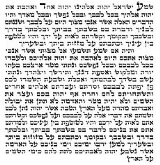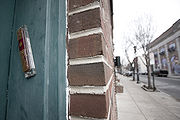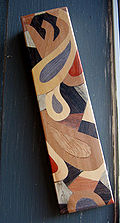
Mezuzah
Encyclopedia
A mezuzah is usually a metal or wooden rectangular object that is fastened to a doorpost of a Jewish house. Inside it is a piece of parchment
(often contained in a decorative case) inscribed with specified Hebrew
verses from the Torah
( and ). These verses comprise the Jewish prayer "Shema Yisrael", beginning with the phrase: "Hear, O Israel, the LORD our God, the LORD is One"
A mezuzah is affixed to the doorframe in Jewish homes to fulfill the mitzvah
(Biblical commandment) to inscribe the words of the Shema "on the doorposts of your house" . Some interpret Jewish law to require a mezuzah on every doorway in the home apart from bathrooms, and closets too small to qualify as rooms. The parchment is prepared by a qualified scribe (a "sofer stam") who has undergone many years of meticulous training, and the verses are written in black indelible ink with a special quill
pen. The parchment is then rolled up and placed inside the case.
, the mezuzah should be placed on the right side of the door, in the upper third of the doorpost (i.e., approximately shoulder height), within approximately 3 inches (8 cm) of the doorway opening. Care should be taken to not tear or damage the parchment or the wording on it, as this will invalidate the mezuzah, which is considered Torah. Generally, halakha requires that mezuzot be affixed within 30 days of moving into a rented house or apartment. This applies to Jews living in the Diaspora
(i.e., outside of the Land of Israel
). For a purchased home or apartment in the Diaspora, or a residence in Israel (owned or rented), the mezuzah is affixed immediately upon moving in. The reason for this difference is that there is an assumption that when a Jew lives in Israel, Israel shall remain his/her permanent residence, whereas a home in the diaspora is temporary.
 Where the doorway is wide enough, Ashkenazi Jews
Where the doorway is wide enough, Ashkenazi Jews
tilt the mezuzah so that the top slants toward the room into which the door opens. This is done to accommodate the variant opinions of the medieval Rabbi
s Rashi
and Rabbeinu Tam
as to whether it should be placed horizontally or vertically, and also to imply that God and the Torah (which the mezuzah symbolizes) are entering the room. Most Mizrahim, Spanish and Portuguese Jews
(Sephardim) and other non-Ashkenazi Jews affix the mezuzah vertically.
The procedure is to hold the mezuzah against the spot upon which it will be affixed, then recite a blessing:
Any Jew can recite the blessing provided he or she is old enough to understand the significance of the mitzvah. After the blessing, the mezuzah is attached.
When affixing several mezuzot, it is sufficient to recite the blessing once, before affixing the first one.

 The commandment to affix a mezuzah is widely followed in the Jewish world, even by Jews who are not religiously observant. While the important part of the mezuzah is the klaf, or parchment, and not the case itself, designing and producing mezuzah cases has been elevated to an art form over the ages. Mezuzot are produced from a wide variety of materials, from silver and precious metals, to wood, stone, ceramics, pewter, and even polymer clay
The commandment to affix a mezuzah is widely followed in the Jewish world, even by Jews who are not religiously observant. While the important part of the mezuzah is the klaf, or parchment, and not the case itself, designing and producing mezuzah cases has been elevated to an art form over the ages. Mezuzot are produced from a wide variety of materials, from silver and precious metals, to wood, stone, ceramics, pewter, and even polymer clay
. Some dealers of mezuzah cases will provide or offer for sale a copy of the text that has been photocopied onto paper; this is not a valid mezuzah, which must be handwritten onto a piece of parchment by a qualified scribe.
Shaddai
, one of the biblical names of God
, also serves here as an acronym for Shomer Daltot Yisrael, "Guardian of Israel's doors". Many mezuzah cases are also marked with the Hebrew letter ש (Shin), for Shaddai.
is a Caesar cipher
— a one letter shift — of the third, fourth, and fifth words of the Shema, "Adonai, Eloheinu, Adonai", "The Lord, our God, the Lord"; it is written on the back of the case, opposite the corresponding words on the front. This inscription dates from the 11th century and is found amongst the Hasidei Ashkenaz
(medieval German Jewish mystics).
According to the Sephardic custom (minhag
), the phrase is prohibited, and only the Hebrew word (Shaddai) is to be written on the back of the mezuzah. This practice is supported by the Shulchan Aruch
and the writings of the Rambam. The Ashkenazi custom of writing both phrases, however, was supported in the writings of the Remo
.
Parchment
Parchment is a thin material made from calfskin, sheepskin or goatskin, often split. Its most common use was as a material for writing on, for documents, notes, or the pages of a book, codex or manuscript. It is distinct from leather in that parchment is limed but not tanned; therefore, it is very...
(often contained in a decorative case) inscribed with specified Hebrew
Hebrew language
Hebrew is a Semitic language of the Afroasiatic language family. Culturally, is it considered by Jews and other religious groups as the language of the Jewish people, though other Jewish languages had originated among diaspora Jews, and the Hebrew language is also used by non-Jewish groups, such...
verses from the Torah
Torah
Torah- A scroll containing the first five books of the BibleThe Torah , is name given by Jews to the first five books of the bible—Genesis , Exodus , Leviticus , Numbers and Deuteronomy Torah- A scroll containing the first five books of the BibleThe Torah , is name given by Jews to the first five...
( and ). These verses comprise the Jewish prayer "Shema Yisrael", beginning with the phrase: "Hear, O Israel, the LORD our God, the LORD is One"
A mezuzah is affixed to the doorframe in Jewish homes to fulfill the mitzvah
Mitzvah
The primary meaning of the Hebrew word refers to precepts and commandments as commanded by God...
(Biblical commandment) to inscribe the words of the Shema "on the doorposts of your house" . Some interpret Jewish law to require a mezuzah on every doorway in the home apart from bathrooms, and closets too small to qualify as rooms. The parchment is prepared by a qualified scribe (a "sofer stam") who has undergone many years of meticulous training, and the verses are written in black indelible ink with a special quill
Quill
A quill pen is a writing implement made from a flight feather of a large bird. Quills were used for writing with ink before the invention of the dip pen, metal-nibbed pens, the fountain pen, and, eventually, the ballpoint pen...
pen. The parchment is then rolled up and placed inside the case.
Affixing the Jewish mezuzah
According to halakhaHalakha
Halakha — also transliterated Halocho , or Halacha — is the collective body of Jewish law, including biblical law and later talmudic and rabbinic law, as well as customs and traditions.Judaism classically draws no distinction in its laws between religious and ostensibly non-religious life; Jewish...
, the mezuzah should be placed on the right side of the door, in the upper third of the doorpost (i.e., approximately shoulder height), within approximately 3 inches (8 cm) of the doorway opening. Care should be taken to not tear or damage the parchment or the wording on it, as this will invalidate the mezuzah, which is considered Torah. Generally, halakha requires that mezuzot be affixed within 30 days of moving into a rented house or apartment. This applies to Jews living in the Diaspora
Diaspora
A diaspora is "the movement, migration, or scattering of people away from an established or ancestral homeland" or "people dispersed by whatever cause to more than one location", or "people settled far from their ancestral homelands".The word has come to refer to historical mass-dispersions of...
(i.e., outside of the Land of Israel
Land of Israel
The Land of Israel is the Biblical name for the territory roughly corresponding to the area encompassed by the Southern Levant, also known as Canaan and Palestine, Promised Land and Holy Land. The belief that the area is a God-given homeland of the Jewish people is based on the narrative of the...
). For a purchased home or apartment in the Diaspora, or a residence in Israel (owned or rented), the mezuzah is affixed immediately upon moving in. The reason for this difference is that there is an assumption that when a Jew lives in Israel, Israel shall remain his/her permanent residence, whereas a home in the diaspora is temporary.

Ashkenazi Jews
Ashkenazi Jews, also known as Ashkenazic Jews or Ashkenazim , are the Jews descended from the medieval Jewish communities along the Rhine in Germany from Alsace in the south to the Rhineland in the north. Ashkenaz is the medieval Hebrew name for this region and thus for Germany...
tilt the mezuzah so that the top slants toward the room into which the door opens. This is done to accommodate the variant opinions of the medieval Rabbi
Rabbi
In Judaism, a rabbi is a teacher of Torah. This title derives from the Hebrew word רבי , meaning "My Master" , which is the way a student would address a master of Torah...
s Rashi
Rashi
Shlomo Yitzhaki , or in Latin Salomon Isaacides, and today generally known by the acronym Rashi , was a medieval French rabbi famed as the author of a comprehensive commentary on the Talmud, as well as a comprehensive commentary on the Tanakh...
and Rabbeinu Tam
Rabbeinu Tam
Rabbeinu Tam , born Jacob ben Meir, was one of the most renowned French Tosafists and a foremost halachic authority of his generation...
as to whether it should be placed horizontally or vertically, and also to imply that God and the Torah (which the mezuzah symbolizes) are entering the room. Most Mizrahim, Spanish and Portuguese Jews
Spanish and Portuguese Jews
Spanish and Portuguese Jews are a distinctive sub-group of Sephardim who have their main ethnic origins within the Jewish communities of the Iberian peninsula and who shaped communities mainly in Western Europe and the Americas from the late 16th century on...
(Sephardim) and other non-Ashkenazi Jews affix the mezuzah vertically.
The procedure is to hold the mezuzah against the spot upon which it will be affixed, then recite a blessing:
- Barukh atah Adonai Eloheinu melekh ha‘olam, asher kideshanu bemitzvotav vetzivanu likboa‘ mezuzah.
- Blessed are You, Lord our GodNames of God in JudaismIn Judaism, the name of God is more than a distinguishing title; it represents the Jewish conception of the divine nature, and of the relationship of God to the Jewish people and to the world. To demonstrate the sacredness of the names of God, and as a means of showing respect and reverence for...
, King of the Universe, Who sanctified us with His mitzvotMitzvahThe primary meaning of the Hebrew word refers to precepts and commandments as commanded by God...
, and commanded us to affix a mezuzah.
Any Jew can recite the blessing provided he or she is old enough to understand the significance of the mitzvah. After the blessing, the mezuzah is attached.
When affixing several mezuzot, it is sufficient to recite the blessing once, before affixing the first one.
Checking the parchment
Orthodox Jews have a qualified scribe check the mezuzot parchments for defects (such as small tears or faded lettering) at least twice every seven years.Mezuzah cases


Polymer clay
Polymer clay is a sculptable material based on the polymer polyvinyl chloride . It usually contains no clay minerals, and is only called "clay" because its texture and working properties resemble those of mineral clay...
. Some dealers of mezuzah cases will provide or offer for sale a copy of the text that has been photocopied onto paper; this is not a valid mezuzah, which must be handwritten onto a piece of parchment by a qualified scribe.
Additional Inscriptions
It is customary to write two inscriptions on the back of the parchment:- the Hebrew word (Shaddai)
- the phrase
Shaddai
El Shaddai
El Shaddai [shah-'dah-yy] is one of the Judaic names of God, with its etymology coming from the influence of the Ugaritic religion on modern Judaism. El Shaddai is conventionally translated as God Almighty...
, one of the biblical names of God
Names of God in Judaism
In Judaism, the name of God is more than a distinguishing title; it represents the Jewish conception of the divine nature, and of the relationship of God to the Jewish people and to the world. To demonstrate the sacredness of the names of God, and as a means of showing respect and reverence for...
, also serves here as an acronym for Shomer Daltot Yisrael, "Guardian of Israel's doors". Many mezuzah cases are also marked with the Hebrew letter ש (Shin), for Shaddai.
is a Caesar cipher
Caesar cipher
In cryptography, a Caesar cipher, also known as a Caesar's cipher, the shift cipher, Caesar's code or Caesar shift, is one of the simplest and most widely known encryption techniques. It is a type of substitution cipher in which each letter in the plaintext is replaced by a letter some fixed number...
— a one letter shift — of the third, fourth, and fifth words of the Shema, "Adonai, Eloheinu, Adonai", "The Lord, our God, the Lord"; it is written on the back of the case, opposite the corresponding words on the front. This inscription dates from the 11th century and is found amongst the Hasidei Ashkenaz
Chassidei Ashkenaz
The Chassidei Ashkenaz was a Jewish movement in the 12th century and 13th century founded by Rabbi Judah the Pious of Regensburg, Germany and several other German Jews members of the Lehr family and the Kalonymus family.Rabbi Judah was born in Speyer, Germany in 1150 during a time of persecution...
(medieval German Jewish mystics).
According to the Sephardic custom (minhag
Minhag
Minhag is an accepted tradition or group of traditions in Judaism. A related concept, Nusach , refers to the traditional order and form of the prayers...
), the phrase is prohibited, and only the Hebrew word (Shaddai) is to be written on the back of the mezuzah. This practice is supported by the Shulchan Aruch
Shulchan Aruch
The Shulchan Aruch also known as the Code of Jewish Law, is the most authoritative legal code of Judaism. It was authored in Safed, Israel, by Yosef Karo in 1563 and published in Venice two years later...
and the writings of the Rambam. The Ashkenazi custom of writing both phrases, however, was supported in the writings of the Remo
Moses Isserles
Moses Isserles, also spelled Moshe Isserlis, , was an eminent Ashkenazic rabbi, talmudist, and posek, renowned for his fundamental work of Halakha , entitled ha-Mapah , an inline commentary on the Shulkhan Aruch...
.

